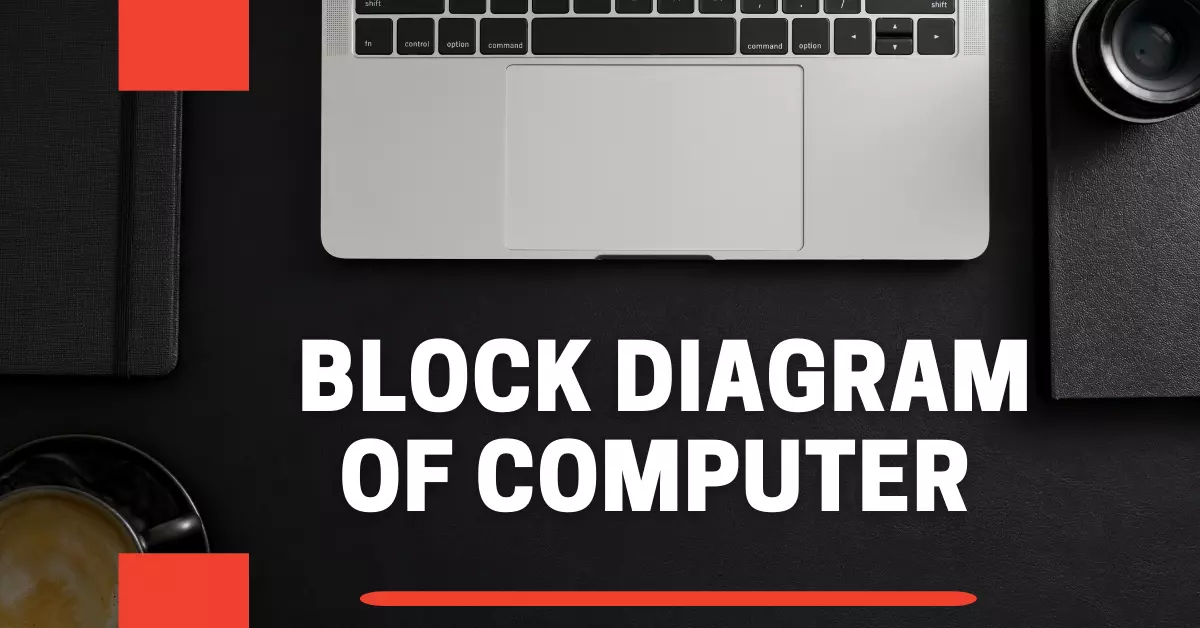Block Diagram of Computer System: The Computer system consists of mainly three types: central processing unit (CPU), Input Devices, and Output Devices.
The Central processing unit (CPU) again consists of ALU (Arithmetic Logic Unit) and Control Unit.
The set of instructions is presented to the computer in the form of raw data which is entered through input devices such as a keyboard or mouse.
Later this set of instructions is processed with the help of the CPU [Central Processing Unit], and the computer system produces an output with the help of output devices like printers and monitors.
A large amount of data is stored in computer memory with the help of primary and secondary storage devices temporarily and permanently.
These are called storage devices.
The CPU is the heart | Brain of a computer because, without the necessary action taken by the CPU, the user cannot get the desired output.
The Central Processing Unit [CPU] is responsible for processing and handling all the Instructions given to the computer system.
Below Block Diagram of Computer and Its Components are mentioned for better understanding.
People Are Also Reading
- Top 10 Advantages and Disadvantages of Computer
- Main Characteristics of Computer System
- What is supercomputer and its Uses
- 10 Limitations of Computer System
- 10 Uses of Multimedia in Various Fields
- 5 Functions of Control Unit in Computer System
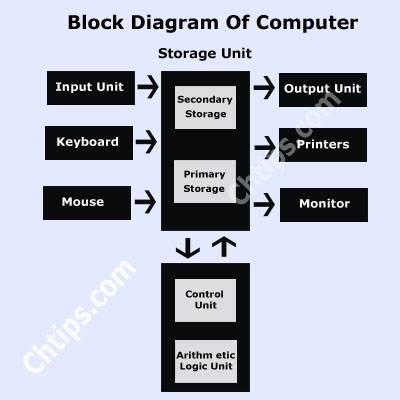
The Basic components & parts of computer system are mentioned
- Input Devices
- Output Devices
- CPU (Central Processing Unit)
- Storage Unit
- ALU(Arithmetic Logic Unit)
- Control Unit
Input Devices of Computer System
The set of instructions or information is provided to the computer system or PC with the help of input devices such as (a keyboard, mouse, scanners, etc. ).
The Instruction or data presented to the computer system is converted into binary form and then supplied to a computer system for further processing.
The Input Unit perform transferring the data from outside the world into the system and later, this data is processed, and the system produces instructions through output units such as printers, monitors, etc.
The Input devices enter the data from outside the world into the primary storage devices.
The input devices are a means of communication with the outside world and our computer system.
- Input Devices accepts or receives data or instruction from outside the world, such as input devices like keyboard and mouse
- It converts the data or instruction, or information into a machine-readable form for further processing & handling.
- Later it supplies the decipherable information to the PC for additional handling
- They act like a connection between the outside world and our computer system
- Keyboards and mouse are prime examples of input devices.
- When the procedure is finished, we get or receive the desired results using output devices such as printers and monitors.
You May Also Like Reading
- 20 Advantages of Internet in Points
- What is a Computer Virus
- What is Computer Hardware and Software
- Impact of Social Media on Students Life
- 10 Uses of Computer in Different Fields With Pictures
- What is Booting in Computer | Types of Booting in Computer
Output Devices of Computer Systems
Computer output devices produce or generate results with the help of devices or gadgets such as a printers, monitors, etc.
Primarily these instructions or data provided to a computer system are in binary code
so to produce or generate the desired output the system has to convert this data into human-readable form.
To do so it has to first present the data or instruction to a computer system for further processing or handling.
With the help and assistance of output devices, the system is linked or connected with the outside world.
For Example, The data or instruction such as Graphics, images, or text is inserted into the computer system with the help of input devices as the data received from the input devices is in binary code, therefore,
The data must be primarily converted into human-readable form after processing the user gets the required or desired data or information set.
The prime examples of Output devices are Printer, Monitor, Projectors etc.
- The output devices receive all the data or instructions in binary code.
- The output devices convert the binary codes into human-readable or intelligible forms for better understanding and better functionality.
- They produce the changed or converted result to the user, which is effectively comprehensible by humans for proper and accurate understanding.
- They connect or link the outside world and the computer system or our PC framework.
- Printers, monitors, and projectors are prime examples of output devices.
![Block Diagram of Computer [Infographic] Block Diagram of Computer [Infographic]](https://www.chtips.com/wp-content/uploads/2021/05/Block-Diagram-of-Computer-System-410x1024.png)
Central Processing Unit (CPU) of Computer System
The Central Processing Unit is also called the brain or heart of a computer.
The CPU is nothing but an electronic hardware device that carries or performs all the operations, such as arithmetic and logic operations.
Below we have discussed briefly arithmetic and logical operations.
The CPU in another term is also called as "PROCESSOR".
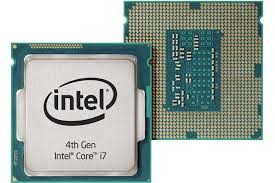
Every instruction given through the input devices such as keyboard or mouse is carried further for processing, and we users get our desired results through are output devices such as printers and monitors.
The CPU is also responsible for controlling all the operations of the other units of the computer system.
When we talk or discuss CPU, we tend to speak about its speed as speed these days matters most due to a large number of large software requiring a fast processor for execution.
The different component of CPU is Arithmetic logical unit And Control Unit.
Top 5 Processor Brands
- Intel
- AMD
- Cyrix.
- Fujitsu
- Hitachi
Control Unit
The Control Unit or CU Controls or coordinates all activities performed in a computer system.
It receives information or instructions, or directions from the main memory of computer.
It tells the logic unit, memory, as well as input and output devices how to handle the program or instruction in proper order.
When the control unit receives any set of information or instructions, it converts them to control signals then these signals are sent to the central processor for further processing. finally, it understands which operation to execute, exactly or precisely, and in which order.
People Are Also Reading
- The Five Generations of Computer System
- A Brief History of Computers
- What is a Computer Virus and Its Different Types
- What is Operating System and Different Types
Arithmetic and Logic Unit
- Arithmetic Unit (AU).
- Logic Unit (LU).
Some processors now have more than a single AU [Arithmetic Unit].
ALU performs arithmetic and logical operations when a set of instructions or programs is conveyed.
The control unit generally characterized which sort of operation to execute.
The arithmetic operation comprises (Addition, subtraction, division, and multiplication) and the logical unit carries out the operations such (as AND, OR, Equal, less than, and greater than), and later the control is changed to ALU, and the result is generated.
ALU is later stored or put away in transitory memory.
Storage Unit of Computer
The information or set of guidelines can be stored in the PC storage unit when information or direction is exhibited to the PC system utilizing Input devices.
To begin the procedure on information, Instructions given by input devices the information must be put away in memory, and later when the preparation is done, the outcome produced is likewise put away in the computer system for additional handling.
The storage unit does this type of work and action. In other words, we can also describe the storage unit as the unit that gives space to store data or instruction of processed data, processed result.
- It stores information or instructions.
- It stores Results.
- It stores the consequences of prepared data.
Storage Devices
The term storage is defined as the devices that store data given by the input devices or output devices after processing; the data is stored in a computer system.
i.e., Primary or secondary storage depends entirely on the data size.
There are mainly two types of storage Unit
- Primary Storage
- Secondary Storage
Primary Storage
They are also called Main memory or in other words RAM (Random Access Memory).
The Data or set of instructions is stored in primary storage before processing, and later the data is transferred to ALU, where further processing is done.
The primary Storage cannot store a huge amount of data, and the data stored in this memory is temporary (The data is lost when there is a power failure),
it is also called temporary memory, and they are very expensive. The other example of primary Storage is the L1 Cache of the Processor.
RAM (RANDOM ACCESS MEMORY)
The RAM is called “Random Access Memory”.
It is a type of volatile memory that cannot store data or information when there is no power supply.
This type of memory is very fast, less expensive, and light in weight.
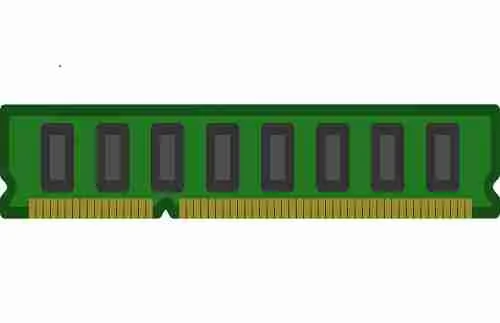
This type of computer memory can transfer data and instructions from the central processing unit [CPU] much faster than secondary storage devices like Hard disks.
The RAM is placed inside the computer system. To be precise, they are installed on a computer motherboard.
Computer RAM is the primary reason for the speed of the modern-day personal computer.
It is used for storing all active programs or instructions so that it can be additionally exchanged for CPU for the additional process.
The technology used in RAM is based on semiconductor integrated circuits. Ram is divided into two more categories.
- Static Ram
- Dynamic Ram
Static RAM.
The static Ram stores binary information in clocked sequential circuits. It is comprised of flip-flops and stores a touch of voltages.
It is a volatile or unstable memory if the power from the data or instructions is destroyed. This kind of memory does not require refreshing.
Dynamic RAM.
Dynamic RAM stores binary information in the form of electric charges connected to capacitors inside the chip.
This type of RAM consumes less power and can store or hold more data and information than static RAM.
ROM (READ-ONLY MEMORY)
ROM Stands for “READ ONLY MEMORY”. They are a non-volatile type of memory that can store data or instruction permanently. They can be used as permanent storage.
End users cannot manipulate, delete, edit, or update instructions inside ROM.
The data can be changed or updated by the programmer with the necessary programming skills and knowledge.
ROM is of different Types
- PROM
- EPROM
- EEPROM
PROM
PROM stands for “Programmable Read-Only Memory” it is also a type of non-volatile memory that is once programmed or customized. The set of instructions stored cannot be deleted, updated, or refreshed.
Computer Programmers write and compose programs or codes in this chip in such a way as to obtain the desired result, and special equipment is used to write programs inside the chip.
EPROM
EPROM stands for “Erasable Programmable Read-Only Memory” As the name suggests, the programs written and composed by computer programmers can be deleted or updated according to the necessities.
One needs to uncover this chip to High Ultraviolet light for over 20 minutes to delete the information. Once exposed, they can be reused after reprogramming.
They should not be overexposed to avoid damage.
You cannot delete or erase a single content from them.
If you try to do it, the whole data or information inside the chip gets deleted or erased.
This type of memory is broadly used as they are cheap and reliable.
EEPROM
EEPROMS stands for “Electrically Erasable Programmable Read-Only Memory” to erase or delete the information or data inside them, one should take the memory outside the PCB (Printed Circuit Board).
As the time required for erasing the information is significantly speedier the EPROMs.
Secondary Storage
Secondary storage is also called a permanent storage unit, as when the data stored in this memory is stored permanently, users can recall it whenever needed.
The data remains in this memory even when there is a power failure or shutdown, and they are much cheaper than primary memory.
The Example of Secondary Storage is Hard disk and Zip drives.
Computer Hard Disk
Computer Hard Disks are also called hard drives, HDDs (Hard Disk drives), and Fixed Disks.
They are used as a secondary storage device, they are a non-volatile memory (Data is not lost when power is off)
They are the cheapest and fastest devices that are used for data storage.
Modern Hard disk comes in huge data storage capacities such as 160 GB,250 GB, 500 GB,1 TB, and 2 TB.
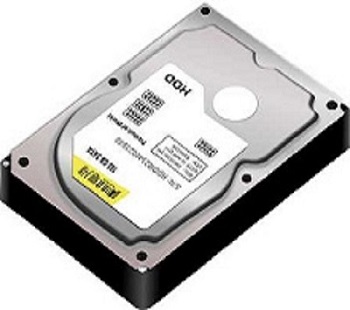
They have a rotation speed of 7200 rpm, 9200 rpm (Revolution Per Minute), and 15000 rpm, and the access speed of hard drives is approx. 1000 kb per second.
Computer Hard disk was first introduced in 1956 by IBM. They are the most crucial part of the computer system, where all the important data can be stored almost permanently.
Hard drives are made up of rigid materials, it has a disk-shaped platter made up of aluminium or glass and are coated with a thin layer of magnetic material the platters are hard and cannot be bent, therefore, are called fixed disk.
The sizes of disk platters vary from 1 to 14 inches in diameter.
HDD records data by magnetizing ferromagnetic material directionally to represent either 0 or 1 in a binary form.
Pen Drives | Zip Drives | Thumb Drives
Pen drives are used extensively in the world they have replaced CDs and Floppy Disk due to their massive records storing capability and quicker information transferring speed.
Pen drives and USB flash drives are linked to a USB (Universal Serial Bus) Port which is accessible on PC motherboards they are used except for any extra electricity they acquire the energy from the USB port itself and subsequently take part in a dominant function in the PC world.
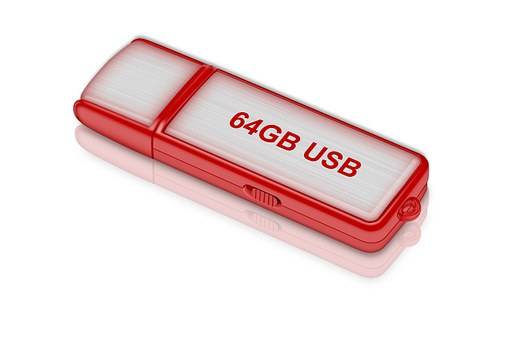
Pen drives, USB Flash drives, and thumb drives come in large storage capabilities from 2 GB to 128 GB.
The USB Memory Stick comes with one-of-a-kind built-in facets embedded in itself such as a built-in camera, built-in audio, and video enjoying applications.
These pen drives allow users to copy records from one laptop to another with ease with no data loss.
The USB Memory Stick and USB flash drives are Plug and play units i.e. they do not require any extra drives or software programs hardware or utility to run effortlessly.
Modern Pen drives come in 3.0 and 4.0 speeds which are much faster compared to previous drives.
Digital Versatile Disk [DVD]
DVD stands for Digital Video Disk or Digital Versatile Disk.
DVD or optical disk is widely used for storing digital content material for each Personal computer system and some digital products.
DVDs can store almost 7 times more data than CDs. Physically both CD and DVD are of the same diameter and thickness which is 5.25’’.
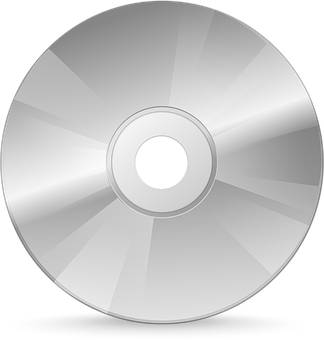
DVD comes in 4.7 GB on a single layer and nowadays it comes in 8 GB on a double-layer disk.
- The Optical Disk is cheaper, light in weight, easy to handle, and easy to store data.
- In an Optical Disk data can be almost permanently stored.
- The optical disk has a very high storage density therefore you can store a huge amount of data.
- As there is no read/write head there is no risk of the head crashing against the disk surface.
- The optical is usually circular therefore the data is stored in proper order.
- The DVD is smaller in size, therefore, needs to require less space.
People Are Also Reading
- Learn Brief History of Computer
- What are Input Devices of Computer
- Different Types of Computer
- Output Devices of Computer
- 9 Types of Pointing Devices
- Computer Basic Tutorials
Useful Video On: Block Diagram of Computer
Block Diagram of Computer PDF Download
Block Diagram of Computer and its Functions.
The central processing unit [CPU] is crucial to any computer system. It is also considered the brain or heart of a computer system.
The CPU performs all the computational calculations inside the computer system.
The CPU consists of small sections called “cores“, which are miniature CPUs within one larger processor chip.
The RAM [Random Access Memory] is considered “Volatile Memory“. That means the data and information are lost when there is a power loss or electricity failure.
The data, instructions and information stored in RAM are Temporary.
The instruction in the RAM must be used and utilized instantly as the data does not stay long in RAM compared to other secondary storage devices.
The RAM is also responsible for the speed of the computer system. The more RAM you have installed in your system, the faster it will run.
The main and important components of any computer system are.
- CPU.
- Motherboard.
- Hard Disk.
- RAM.
- ROM.
- Graphics Card or Video Card.
The components of a computer system are classified under two categories.
- Internal Components.
- External Components.
Internal Components.
Internal Components are installed or embedded inside the computer system, just like motherboard, RAM or hard disk drives.
External Components.
External Components are removable devices connected to a computer system with the help and assistance of a USB port or cables or without wires like a mouse, webcam, or keyboard.
The block diagram of the computer and its functions can be explained with the help and assistance of a diagram that presents and shows the internal components of the computer system.
They also describe and explain how components function and interact with each other using the block diagram of a computer and its functions using a diagram, flowcharts, maps, and other visual representations,
4 Functions of Computer
- Input
- Output
- Processing
- Storage
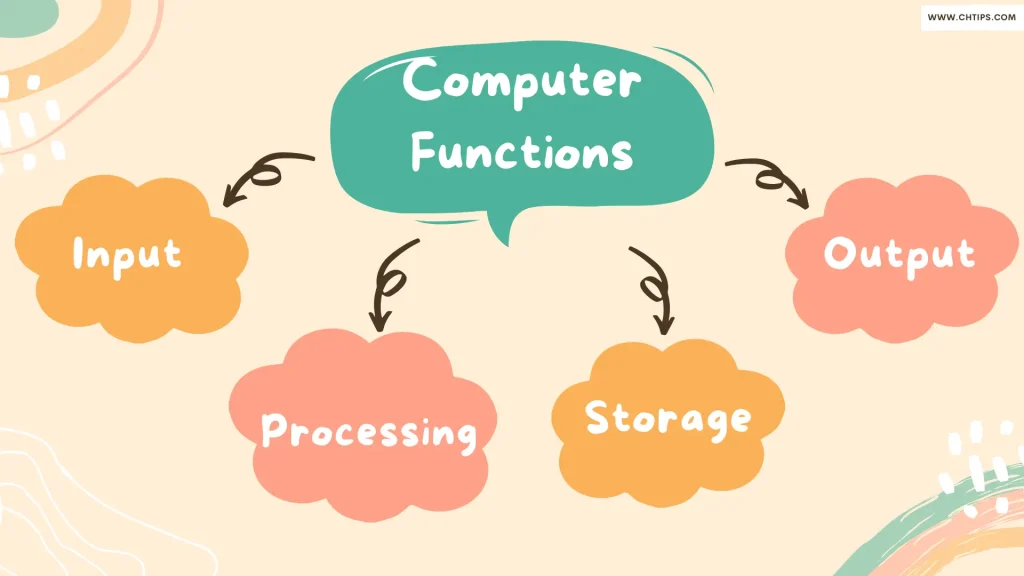
Functional Unit of Computer Block Diagram?
- Input Unit
- Output Unit.
- Central Processing Unit.
- Memory Unit Arithmetic & logical Unit.
- Control Unit.
Basic 6 Components of Computer System
The basic components of computer are mentioned below.
- Input Devices
- Output Devices
- Central Processing Unit [CPU]
- Control Unit [CU]
- Arithmetic Logic Unit [ALU]
- Storage Unit
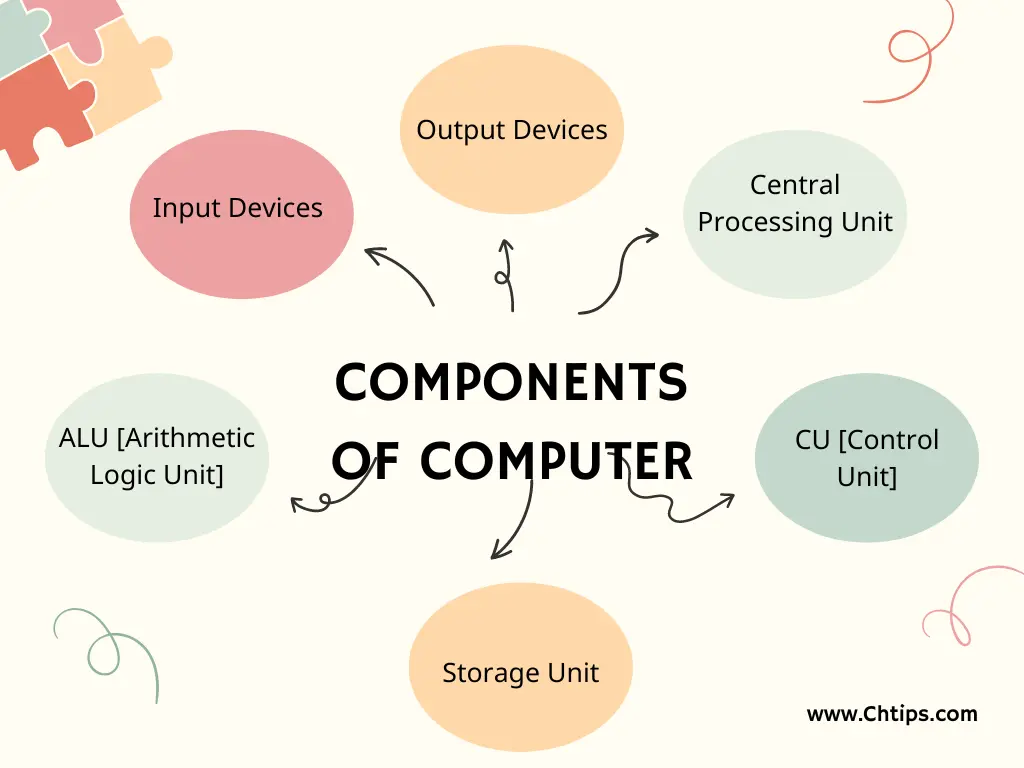
Cache Memory of Computer System
Cache memory resides between primary memory and CPU [Central Processing Unit].
They are extremely expensive therefore the manufacturer uses them in low numbers.
- They are fast and reliable.
- They are likewise called high-speed semiconductors.
- They are primarily responsible for accelerating the CPU.
- They store the data which is frequently used by the “COMPUTER PROCESSOR”.
- This program or information is transferred and exchanged from disk to cache memory with the assistance of the operating system so that Processor can access them.
- They are considerably much faster than main memory the data exchanging time is less as compared to main memory.
- This is one of the fastest computer memory used in computer systems.
- The powerful computer uses more cache memory to speed up the information transfer and exchange process.
Learn Block Diagram of Computer Using Image
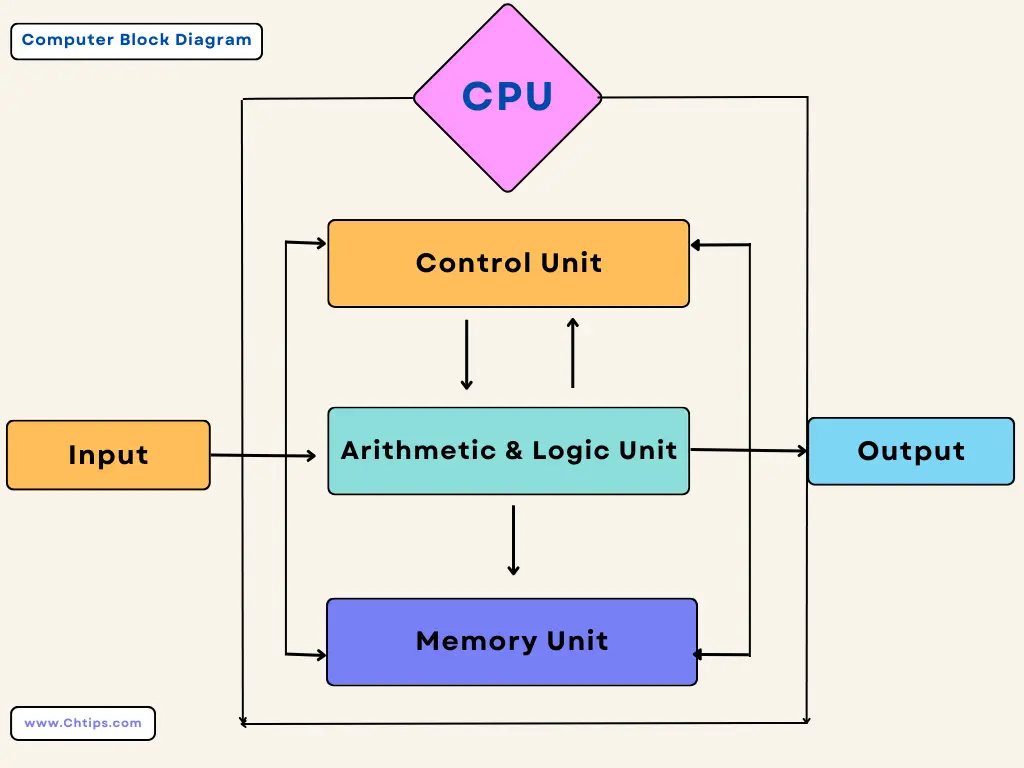
What are the Basic Blocks of a Computer?
Memory Unit, Control Unit, Arithmetic and Logical Unit.
Registers & Their Types
A CPU [central processing unit] contains various registers to store information temporarily during the execution of a program.
The number of registers varies from processor to processor. Some processor contains more registers some processors contains fewer registers.
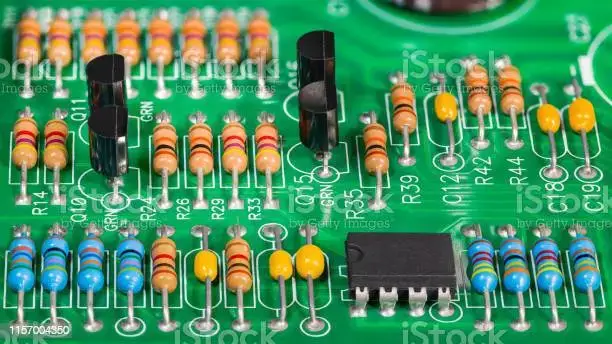
Registers are classified as follows
- General Purpose Registers
- Accumulator
- Special Purpose Registers
- Status Register or Flag Register
- Instruction Register
- Index Register
- Memory Address Register (MAR)
- Memory Buffer Register (MBR) or Data Register (DR)
General Purpose Registers
These registers store data and intermediate results during the execution of a program. They are accessible to users through instructions if they work in assembly language.
The accumulator is the most important general-purpose resister having multiple functions.
It is most efficient in data movement arithmetic and logical operations; its functions depend on the processor’s design, whether the processor is an accumulator-based processor or a general-purpose registers-based processor.
They have some special features that the other general-purpose registers do not have.
In an accumulator-based processor design, the accumulator holds one of the arithmetic and logical operations operands.
After the execution of arithmetic and logical instructions, the result is placed in the accumulator; all data transfers between CPU and device /port are performed through the accumulator
Special Purpose Registers
A CPU contains several special-purpose registers for different purposes theses are:
- Program counter
- Stack pointer
- Status register
- Instruction register
- Index register
Memory address registers, memory buffer register
All CPUs do not contain all of these special registers. A powerful processor contains the majority of them.
A brief description of these registers is mentioned below.
The program counter (PC) The program counter keeps track of the address of the instruction/data which is to be executed next.
So it holds the address of the memory location which contains the next instruction to be fetched from memory.
Stack Pointer
The stack is a sequence of a memory location defined by the users. It is used to save/store the contents of a register if it is required during the execution of the program.
Stack Register or Flag Register
A flag register contains many flags either to indicate certain conditions arising after arithmetic and logical operations or to control certain operations.
Instruction Registers.
it holds an instruction until the data is decoded.
Some computers have two instruction registers and so they can fetch and save the next instruction while the execution of the previous instruction is going on.
Index Registers
index registers are used for addressing. One or more registers are designated as index registers.
Memory Address Registers (MAR)
it holds the address of the instructions /data to be fetched from the memory.
The CPU transfers the address of the next instruction from the program counter (PC) to the memory address register.
Memory Buffer Register (MBR) or Data Register (DR)
It holds or saves the instructions code or data received from or sends to the memory. It is connected to the data bus the data which are written into the memory
Are stored in the registers until the write operation is completed.
Block Diagram of Computer Network
Computer networks connect computers and devices to share critical data and information within the network.
Different types of computer networks are listed below.
- LAN {Local Area Network}.
- WAN {Wide Area Network}.
- PAN {Personal Area Network}.
- MAN {Metropolitan Area Network}.
- VPN {VIRTUAL PRIVATE NETWORK}.
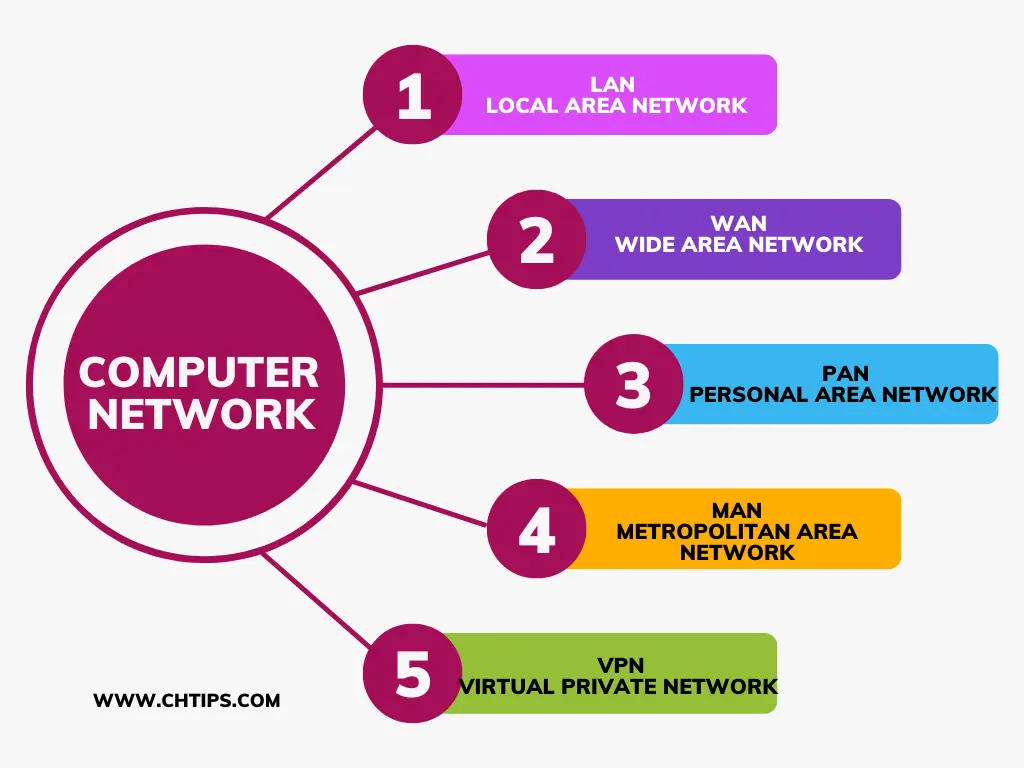
In a computer network, data and resources are shared limitedly or extensively.
A block diagram of a computer network can be expressed simply as the graphical representation of the components of the computer system and different types of networks with their topologies.
The computer, devices, or nodes communicate within the network. A computer network is a group of computers that are connected.
Computer networks can be done with wired or wireless networks.
1. LAN {Local Area Network}.
LAN stands for Local Area Network.
In a Lan network, two or more devices, computers, or nodes are connected for data and information sharing.
Printers, internet, applications, and other resources are shared in LAN networks.
2. WAN {Wide Area Network}.
WAN stands for Wide Area Network.
WAN networks usually cover a large area that provides internet services within countries and continents.
WAN networks have a range between substantial geographical regions.
3. PAN {Personal Area Network}.
Full-Form of PAN in Computer is Personal Area Network.
PAN computer networks are primarily used and utilized for connecting devices like smartphones, computers, laptops, etc., that can be handled by the network individually.
PAN networks, with ease in communications, are instrumental in data and information sharing.
A PAN network can be established with the help and assistance of WI-Fi, LAN, and Bluetooth.
4. MAN {Metropolitan Area Network}.
The full form of MAN is Metropolitan Area Network.
MAN is a more extensive network than the local Area Network but smaller than WAN Wide Area Network.
A Metropolitan Area Network links or connects to the LANs and through the internet to the MAN with the network.
MAN provides high-capacity data that customer needs, and it can provide a lower cost and excellent efficiency than obtaining local service from the telephone company.
5. VPN {VIRTUAL PRIVATE NETWORK}.
VPN stands for Virtual Private Network.
VPN is a network technology used for network security for public and private networks.
VPNs usually hide the user’s location, identity, and IP address for an additional layer of security.
They are also used and utilized for data and information security.
10 Main Parts of Computer System
| 1 | Central Processing Unit | Processor | CPU. |
| 2 | Motherboard. |
| 3 | RAM [Random Access Memory]. |
| 4 | Hard Disk Drives | SSD [Solid State Drives]. |
| 5 | Switching Mode Power Supply [SMPS]. |
| 6 | DVD RW. |
| 7 | Cabinet | Case. |
| 8 | Monitor. |
| 9 | Keyboard |
| 10 | Mouse. |
Frequently Asked Questions [FAQs] on Block Diagram of Computer
How Many Units is a Computer Block Diagram
What are the 4 Main Components of a Computer
Who is the Father of Computer
What is the First Modern Computer
Which is the World’s First Supercomputer?
Most Important Part of a Computer Block Diagram?
Types of Computer
Get In Touch
I have also written and compiled some articles on computers and telecommunications, and please go through them.
I hope you will like reading it.
All the questions and queries related to Block Diagram of Computer System are answered here.
If you have any questions about the Computer Network Block Diagram.
Don’t hesitate to contact me, and if you feel to add, remove or update anything from the article, please let me know in the comment section or via email.
I will be more than happy to update the article. I am always ready to correct myself.
Please share this article with your friends and colleagues; this motivates me to write more related topics.
!!! Thank You For Reading !!!
